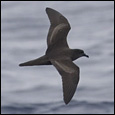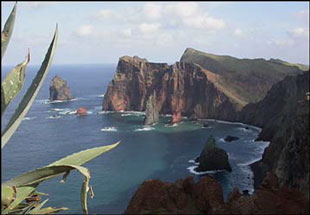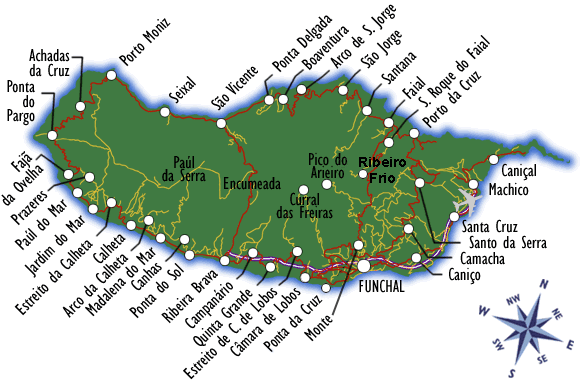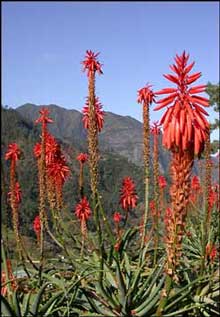
 |
| Part
of the easternmost tip, Ponta de São Lourenço. Photo: Raphael Jordan, France. |
Together with the Azores, Selvagens Islands, the Canaries and the Cape Verde Islands, the Madeiran archipelago forms the region called Macaronesia (from Greek "makaros"=happy and "nesos"=island).

 |
| Beautiful flowering
cactus. Photo: Raphael Jordan, France |
Fauna and flora
There are no dangerous animals such as snakes, scorpions or spiders on
the island so it is possible move freely without concern unless you are
scared of heights. However, on Deserta Grande you could, with luck, find
the highly poisonous Desertas' Tarantula (Lycosa ingens). Its length
including the legs measures 8 cm and this makes it the largest spider
of its genus in the world.
Madeira is often referred too as the 'Flower island
in the Atlantic', which without doubt is true. What strikes you, however,
after a few days on the island is the silence and absence of insects.
Anyone with the smallest interest in the natural world may wonder 'All
this floral splendour, but no insects to be seen or heard? How come?'
This fact combined with the relatively low numbers of landbirds make the
outdoors beyond the citys somewhat quiet and this makes most bird calls
very conspicuous. There is never a concert of singing birds on Madeira!
What you probably will see of the land animals is Madeiran
Wall Lizards in high numbers, a few species of butterflies and at night
you will hear some crickets, for more information take a look at the 'Non-birds'
section.
Without doubt Madeira's flora is one of the main tourist
attractions on the island. About 118 of the naturally ocurring species
are endemic to the Madeiran archipelago. Before man set his foot on the
island, about 793 fern-related and flowering plants grew naturally on
Madeira. Since then, mostly by human intervention, some further 540 plants
have gained a foothold. However, the arrived flora is something to behold.
Like the Canary Islands, Madeira was once covered in Laurel forest, and
although now much reduced the forest on Madeira (together with La Gomera
in Canaries) is the largest and best-preserved area of this particular
habitat left on earth!
Climate and clothing
The climate is pleasantly steady and mildly subtropical. Never too warm
and never too cold. Its average temperatures, 22-25ºC in the summer
and 16ºC in the winter, and a moderate level of humidity, confer
upon these islands exceptional subtropical features. The seawater temperature
is also very mild because of the influence of the warm Gulf current, with
averages of 22ºC in the summer and 16º in the winter.
At low altitudes along the coast T-shirt/shirt and shorts/thin
trousers can be worn all year round, especially along the southern coast
line. When seawatching along the northern coast line or on pelagics a
wind jacket and trousers is recommended. Visiting higher altitudes up
in the mountains will often require warmer clothing and a water/wind proof
jacket, especially when searching for the endemic Zino's Petrel at night
in Pico do Arieiro. Good walking boots and something on your head are
necessities you can't afford to be without.
| Weather data | ||||||||||||
| Average |
Jan
|
Feb
|
Mar
|
Apr
|
May
|
Jun
|
Jul
|
Aug
|
Sep
|
Oct
|
Nov
|
Dec
|
| Day temp |
19
|
19
|
19
|
20
|
21
|
22
|
24
|
25
|
25
|
24
|
22
|
20
|
| Night temp |
13
|
13
|
14
|
14
|
15
|
18
|
19
|
20
|
19
|
18
|
16
|
14
|
| Sun hours |
5
|
6
|
6
|
7
|
8
|
6
|
8
|
8
|
7
|
7
|
5
|
5
|
| Rain days |
7
|
6
|
7
|
4
|
2
|
1
|
0
|
1
|
2
|
7
|
7
|
7
|
| Water temp |
15
|
14
|
14
|
15
|
17
|
18
|
21
|
22
|
21
|
19
|
17
|
16
|
Check
the weather and forecast for Madeira
Useful facts about the Madeira archipelago
Area: 794 sq km (of which Madeira is 741 sq km)
Population: 253.000 (of which Porto Santo has 3.500)
Capital city: Funchal (population; 108.000)
People: It is only in recent years that one can talk of the Madeirense
as a collective society, since the topography of the island had previously
been more conducive to the separate development of the various communities
on the island. By nature Madeirans are farmers, the island having been
originally settled by people from the Algarve region of Portugal.
Language: Portuguese is the national language, English is taught
in schools and is used daily in commerce and international trade.
Government: Madeira is an autonomous region of Portugal. Autonomy
was granted soon after the revolution of the 25th April 1974, that swept
away the last vestiges of the Salazar dictatorship, that had governed
mainland Portugal, the islands and the colonies since 1928. Despite Madeira's
autonomous status, most of the laws enacted by the central government
and by the Portuguese parliament are fully applicable in Madeira.
Visas: Visas are not needed by citizens of the European Union.
Health risks: There are no major risks.
Water: There is plenty of water to an excellent drinking standard.
Porto Santo uses treated seawater. But to be sure you better use bottled
water.
Electricity: 220V. Plugs as in Scandinavia and continental Europe
with two round pins.
Currency: € EURO
To calculate the counter-value of the EURO in your currency unit (brittish
pound, american dollar etc) you can use the calculator of the X-RATES
website:
www.x-rates.com/calculator.html
Banks: Banks are open from 8:30 to 15:00hrs, Monday to Friday.
Foreign Exchange offices work from 9:00 to 13:00hrs and from 14:00 to
19:00hrs, every day, except on Saturdays when they open from 9:00 to 19:00hrs.
Outside these periods, the hotels can change currency.
There are plenty of MultiBanco ATMs (Automated teller
machines) in Funchal and a couple in the citys around the island and on
Porto Santo, which accept most cards such as Visa, MasterCard, Visa Electron
and so on to draw money.
Post: The main post office, or "Correios de Portugal",
is at the centre of Funchal, at the Avenida Calouste Gulbenkian. There
are daily collections at 11:00 and 15:00 from the post boxes (coloured
red) placed all over the island.
Chemists: Chemists are open from Monday to Friday from 9:00 to
13:00 and from 15:00 to 19:00, on Saturdays from 9:00 to 13:00. In addition,
at the door of every pharmacy you will find advisory notes about the pharmacies
currently open.
Hospital Centres: There are 67 health centres situated around Madeira,
and one at Porto Santo. In Funchal there are two hospitals.
Police: The police presence is very discreet. If you need help,
dial 112. There is a Lost Property section in Funchal, at Rua da Infância,
28.
Safety: Madeira is one of the safest holiday destinations in the
world. If you take sensible precautions, you probably won't experience
any problems. Most of the hotels have safes or deposit boxes where you
can keep your valuables.
Copyright © 2004-2013, All rights reserved
Contact: Birding Madeira